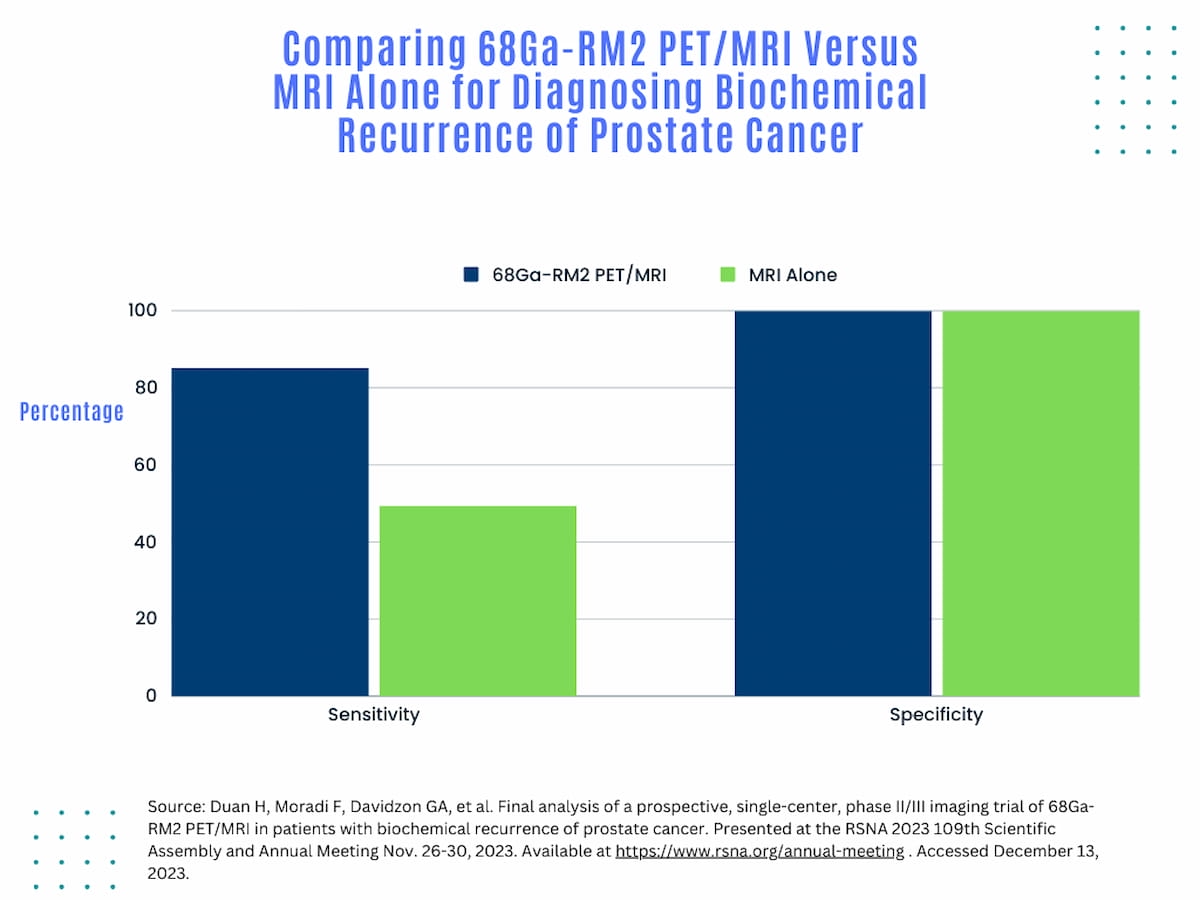Can an Emerging PET Radiotracer Enhance Detection of Prostate Cancer Recurrence?
The use of 68Ga-RM2 PET/MRI demonstrated a 35 percent higher sensitivity rate than MRI alone for the diagnosis of biochemical recurrence of prostate cancer, according to research recently presented at the Radiological Society of North America (RSNA) conference.
New research suggests that targeting gastrin releasing peptide receptors (GRPRs) with 68Ga-RM2 PET/MRI may significantly enhance the diagnosis of prostate cancer recurrence.
For the prospective phase II/III study, recently presented at the Radiological Society of North America (RSNA) conference, researchers compared 68Ga-RM2 positron emission tomography (PET)/magnetic resonance imaging (MRI) vs. MRI alone in 100 men with a post-prostatectomy prostate specific antigen (PSA) level > 0.2 ng/mL or a PSA level > above nadir after radiotherapy.
Findings from the research revealed that 68Ga-RM2 PET/MRI had an 85.2 percent sensitivity rate for diagnosing biochemical recurrence of prostate cancer in comparison to a 49.4 percent sensitivity rate for MRI alone.
While both modalities offered comparable specificity at 100 percent, 68Ga-RM2 PET/MRI had an 85.2 percent sensitivity rate for diagnosing biochemical recurrence of prostate cancer in comparison to a 49.4 percent sensitivity rate for MRI alone.

While both modalities offered comparable specificity at 100 percent, use of 68Ga-RM2 PET/MRI led to a significantly higher detection of prostate cancer lesions (143 vs. 96 for MRI alone), according to the research, which was awarded with the RSNA 2023 Trainee Research Prize in the Nuclear Medicine and Molecular Imaging category
Noting that GRPRs are overexpressed in prostate cancer, study author Heying Duan, M.D., M.B.A, said 68Ga-RM2 PET/MRI may prove to be a viable option for diagnosing and facilitating timely intervention for biochemical recurrence of prostate cancer.
“The collective findings of this comparative imaging trial and other published studies provide compelling evidence that 68Ga-RM2 PET/MRI not only outperforms conventional imaging with MRI but also shows higher reliability and number of lesions detected, which could potentially affect subsequent patient management,” wrote Dr. Duan, a postdoctoral research fellow at the Stanford University School of Medicine.
Reference
1. Duan H, Moradi F, Davidzon GA, et al. Final analysis of a prospective, single-center, phase II/III imaging trial of 68Ga-RM2 PET/MRI in patients with biochemical recurrence of prostate cancer. Presented at the RSNA 2023 109th Scientific Assembly and Annual Meeting Nov. 26-30, 2023. Available at https://www.rsna.org/annual-meeting . Accessed December 13, 2023.
(Editor’s note: For related content, see “Seven Takeaways from Meta-Analysis of PSMA Radiotracers for Prostate Cancer Imaging,” “Emerging Insights in Diagnosing Recurrent Prostate Cancer in Men with Low PSA Levels” and “Can an Emerging PET Radiotracer be a Viable Alternative to Multiparametric MRI for Detecting Prostate Cancer Recurrence?”)
What New Research Reveals About Novice Use of AI-Guided Cardiac Ultrasound
April 4th 2025In a study recently presented at the American College of Cardiology (ACC) conference, researchers found that novice use of AI-guided cardiac ultrasound after an AI-enabled electrocardiogram increased the positive predictive value for reduced left ventricular ejection fraction (LVEF) or aortic valve stenosis by 33 percent.
The Reading Room: Artificial Intelligence: What RSNA 2020 Offered, and What 2021 Could Bring
December 5th 2020Nina Kottler, M.D., chief medical officer of AI at Radiology Partners, discusses, during RSNA 2020, what new developments the annual meeting provided about these technologies, sessions to access, and what to expect in the coming year.
RSNA 2020: Addressing Healthcare Disparities and Access to Care
December 4th 2020Rich Heller, M.D., with Radiology Partners, and Lucy Spalluto, M.D., with Vanderbilt University School of Medicine, discuss the highlights of their RSNA 2020 session on health disparities, focusing on the underlying factors and challenges radiologists face to providing greater access to care.
New AI-Enabled Portable Ultrasound May Facilitate 50 Percent Reduction in Cardiac Imaging Scan Time
March 28th 2025Artificial intelligence (AI)-powered measurement capabilities provide key features with the Compact Ultrasound 5500CV device, which was unveiled at the American College of Cardiology (ACC) conference.
GE HealthCare Launches PET MPI Agent Flyrcado at ACC Conference
March 28th 2025The positron emission tomography myocardial perfusion imaging (PET MPI) agent, which offers a significantly higher half-life than other cardiac PET agents, was recently granted pass-through payment status by CMS that will go into effect on April 1, 2025.